AnAnalysisOfTheOverseasHandlingOfFrontMission
An Analysis Of The Overseas Handling Of Front Mission
- Introduction
- Front Mission
- Front Mission: Gun Hazard
- Front Mission 2
- Front Mission Alternative
- Front Mission 3
In 1994, a young Toshiro Tsuchida planned to create a new intellectual property (IP) that would break away from the Japanese norm and eventually become an international sensation. After having made numerous action and shooter-based video games that catered to the niches in Japan, Tsuchida wanted to craft something that could be enjoyed by people all over the world. This IP would later be given the name Front Mission. While Front Mission has transcended its video game roots and has withstood the tests of time in Japan, its overseas reception has been shockingly poor.
There are many possible reasons that can be given for this, but it really comes down to just one – Front Mission's overseas handling. Whether it was by canceling in-progress localizations, censoring mature story events, or poorly marketing the localized releases, Square Co., Ltd. and Square Enix Co., Ltd. should be very ashamed of the missed golden opportunities they had to turn Front Mission into an international sensation.
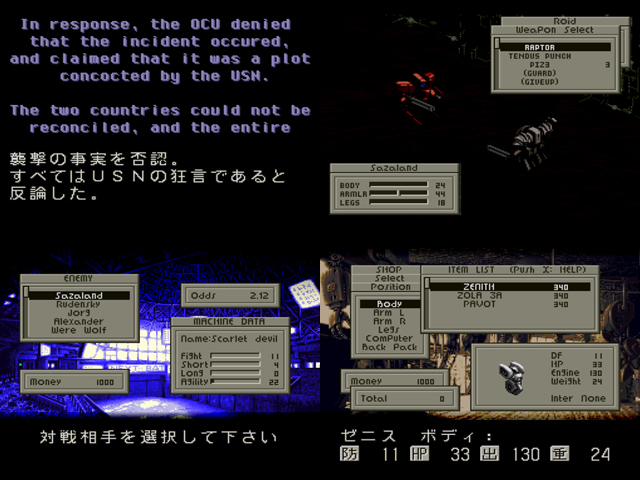
Front Mission's English portions, in preparation for localization.
When the original Front Mission was released for the Nintendo Super Famicom (SNES in Western markets) on February 24, 1995, Japanese magazine publication Famitsu Weekly conducted an interview with G-Craft. In that interview, the question of an overseas localization was presented to G-Craft. In particular, Famitsu Weekly asked why parts of the video game, such as the user interfaces and game data, were in English. G-Craft responded that they intentionally developed Front Mission with an overseas localization in mind, and even hired English translators and editors for the task. Tsuchida explained the time and costs behind a localization effort; the move to partially localize Front Mission was designed to make it easier for any publisher to produce an English localization.
It would not be long before Western magazine publications such as GamePro and Electronic Gaming Monthly were covering the English localization of Front Mission. The video game, along with Bahamut Lagoon, were being localized and prepared for release in the Western markets. However, these localization efforts were eventually canceled by Square Co., Ltd. No reason for this cancellation exists, although one could argue that it would not be financially beneficial as 1995 represented the twilight years of the Super Famicom.
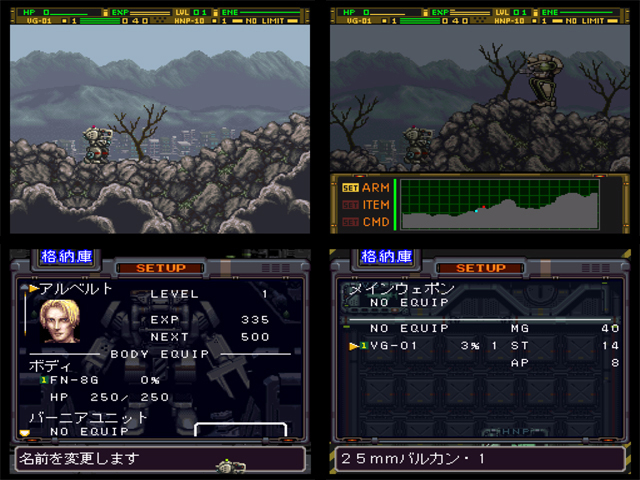
Front Mission: Gun Hazard's English portions, in preparation for localization.
Almost a year after Front Mission was released, Front Mission: Gun Hazard saw the light of day for the Super Famicom on February 23, 1996. Co-developed by G-Craft and Omiya Soft, the video game had been partially translated into English in preparation for an overseas releases. Front Mission: Gun Hazard received attention from Western magazine publications, just like Front Mission was a year ago. Sadly, there was no hints of localization in the aforementioned publications. One could argue that the video game's late release in 1996 was a significant factor for Square Co., Ltd. not to localize it into English, as very few Japanese Super Famicom games were released overseas at this point.
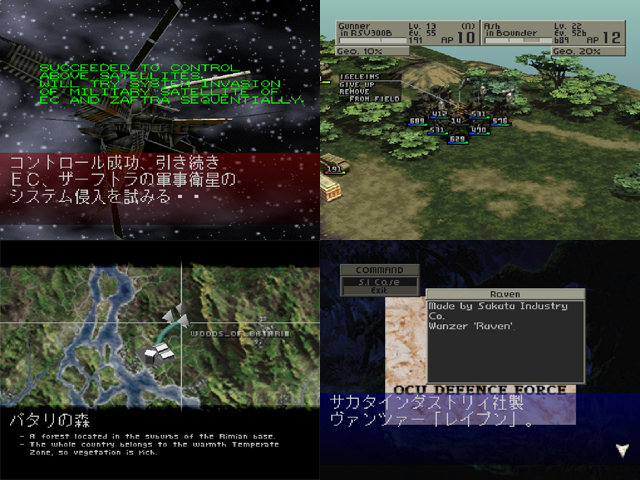
Front Mission 2's English portions, in preparation for localization.
More than a year later since Front Mission: Gun Hazard, Front Mission 2 was released for the Sony PlayStation on September 25, 1997. Representing the new age of gaming technology and 3D visuals at the time, Front Mission 2 was a critical and commercial success. The video game was also featured in many import gaming columns from Western magazine publications. In a more aggressive push to introduce Front Mission outside of Japan, G-Craft hired more English translators and editors for the project. The end result was a video game which had significantly more English text than what one could find in a Japanese-developed product; roughly 30% of Front Mission 2's dialogue was in English.
With a good chunk of time and costs already taken care of, a localization sounds like a good idea, right? Apparently, Square Co., Ltd. didn't think so. The reasoning behind it wasn't reveal until many years later at the Electronic Entertainment Expo 2007 gaming conference. Series PR manager and developer Koichiro Sakamoto revealed that Front Mission 2's mature, adult-themed content was a major factor in the company not releasing the video game outside of Japan. Sakamoto did admit, however, that the aforementioned content would not be out of place in the modern gaming industry (a result of the acceptance of mature games such as Grand Theft Auto or Max Payne).
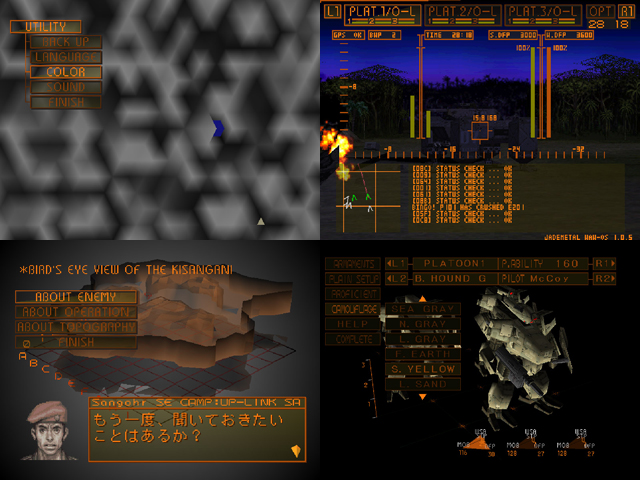
Front Mission Alternative's English portions, in preparation for localization.
English Preview, GameFan Magazine
Months after Front Mission 2, Front Mission Alternative became the second release for the PlayStation on December 18, 1997. Like the Front Mission titles before it, it was developed with localization in mind. Unlike the previous games, Front Mission Alternative included an option to change the user interface from Japanese to English text at any given time. This option also changed all of the game data as well, leaving only the story events still in Japanese. Just like with Front Mission 2, a significant amount of the work needed for a proper localization was taken care of by the developers. A localization was indeed in the works according to a preview in magazine publication, GameFan, in summer 1997. Sadly, Square Co., Ltd. did nothing with the localization, and allowed Front Mission Alternative to remain Japan-only.
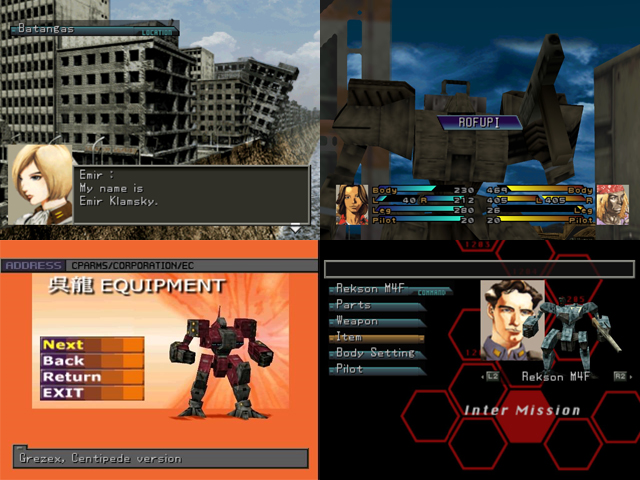
A portion of Front Mission 3's localization blunders. Mistakes shown: Emir Klamsky (correct: Emir Kramskoi), Grezex (correct: Grille Sechs), Rekson (correct: Recson), and ROFUpI (correct: Speed I).
Original Graphic Suicide VS Censored, Edited Suicide Event Comparisons
After four failed attempts to introduce Front Mission overseas, Square Co., Ltd. finally decides to actually take advantage of the opportunity given to them. A few months after Front Mission 3 was released for the PlayStation on September 2, 1999 in Japan, it was eventually released in North American and European markets. All of this sounds great for everyone outside of Japan, right? Not quite. Despite going through with the localization process, the company decided that Front Mission 3 was a little too mature for the Western markets...and censored the video game. A notable censor involved the graphic suicide of one of Front Mission 3's antagonists. Likewise, the storyline saw numerous edits to eliminate any form of continuity from the previous Front Mission titles. This was likely done as no other Front Mission title had seen the light of day outside Japan.
Finally, the quality of the localization itself was poor; grammar mistakes were easy to pick up and amateurish translation mistakes were well evident in the most simplest of things – names, places, etc. Some of this can be attributed to the fact that Front Mission 3 was the first localized title, but even then, many of the mistakes made shouldn't even be there.
Click here for Part Two, or here for Part Three.
